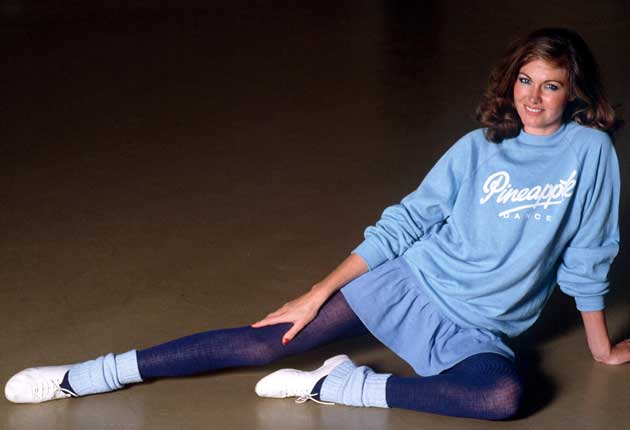The clothes from Fame
It was the label that introduced the world to legwarmers and leotards, and now Pineapple is the star of a new exhibition. Harriet Walker on a dance sensation

All the kids from Fame wanted to do was live forever. Sadly though, the programme died a death when the Eighties became an unmentionable era that everyone wished to deny their involvement in. But one thing from the New York High School of Performing Arts never went away.
30 Years of Pineapple by Debbie Moore is a new exhibition at the Fashion and Textile Museum in London, focussing on the dancewear brand that made the Eighties what they were. From leggings and off-the-shoulder sweatshirts, to sweatbands and bodysuits, Pineapple pioneered a disco look suitable for the studio and the streets.
"All that was really available for dancers back then was this shiny performance nylon, which wasn't right for rehearsing in," says Dennis Nothdruft, curator of the exhibition. "Moore saw dancers modifying their own outfits – cutting the ends off the tights from their school uniform, for instance – and they were her inspiration."
Moore, who was a model during the Seventies and danced to keep fit, founded the Pineapple Dance Studios in Covent Garden in 1979. It was one of the first accessible, affordable spaces for professional and wannabe dancers to practice and perform in (set up in an old pineapple warehouse, hence its name), and it remains a base for some of the most successful dancers and choreographers in showbusiness, including Kylie Minogue and Beyoncé, as well as offering classes and workshops to the rather less nimble masses. It offers everything from a Michael Jackson tribute class to one-on-one tuition for attention-grabbing routines like the "Single Ladies" dance.
But what brought the Pineapple name to the public eye was the research the brand undertook with DuPont scientists to develop cotton Lycra, without which leggings as we know them would not exist. The stretchy fabric was infinitely preferable to the sturdier nylon that came before it, not only for rehearsing dancers but for women across the world struggling with their waistbands.
"It's a very easy style," adds Nothdruft. "Dancers just added things to it, like skirts over leggings, and it became a look. It was just an extension of their day." It's instantly recognisable, whether your touchstone is Leroy et al or Lady Gaga. The exhibition contains a stretch jersey dress over denim leggings, paired with a bomber jacket. "It makes me think of Neneh Cherry," says Nothdruft. "It was such a zeitgeist and people really picked up on it."
They certainly did – and have been ever since. When the New York branch of Pineapple studios opened in 1982, Madonna was among one of the young movers hurling themselves around in front of the mirrors and the parallel bars, wearing the footless tights, ra-ra skirts and leotards that littered her early career. And designer Donna Karan – credited with reinventing the body suit for the high-fashion set – attended the opening party. There's something about the slouchy, stretchy dancewear that has an enduring hold on the public imagination.
Perhaps it's because dancers always look so amazing (it's those tiny, muscular bodies, with limbs that move as if independent of their torsos). There's nothing more aspirational – or depressingly affirming – than watching a lot of tightly constructed young athletes running around, which is also the reason that Fame and Flashdance had such broad appeal. There's a studied nonchalance about the look, and the unexpected combination of comfort and the quietly elegant, draped cotton strikes a chord with many. It began in 1970s New York with Halston, but Stefano Pilati, creative director of Yves Saint Laurent, created cocktail dresses in marl grey jersey for his spring 2008 collection, and wunderkind Alexander Wang often blends the fabric with leather and suede to create a modern and luxurious take on sportswear.
"There's a definitely a sense of nostalgia to it all," continues Dennis Nothdruft. "It appeals to people, although perhaps only the ones who weren't there first time round. It's comfortable too; there's only so much suffering people are willing to go through." Those who didn't suffer it in the Eighties are embracing the look now, and Pineapple offers a collection on the shopping website Asos.com. Many of the pieces are reissues – sloppy sweats, jersey one-pieces, towelling tube tops. More than you can handle? They're de rigueur amongst the young hipsters of Hoxton and Williamsburg, thanks in part to streetwear chain American Apparel, whose offerings could have been filched from Irene Cara's gym-bag. Pineapple: remember its name.
30 Years of Pineapple by Debbie Moore runs until 24 February; Ftmlondon.org
Subscribe to Independent Premium to bookmark this article
Want to bookmark your favourite articles and stories to read or reference later? Start your Independent Premium subscription today.

Join our commenting forum
Join thought-provoking conversations, follow other Independent readers and see their replies